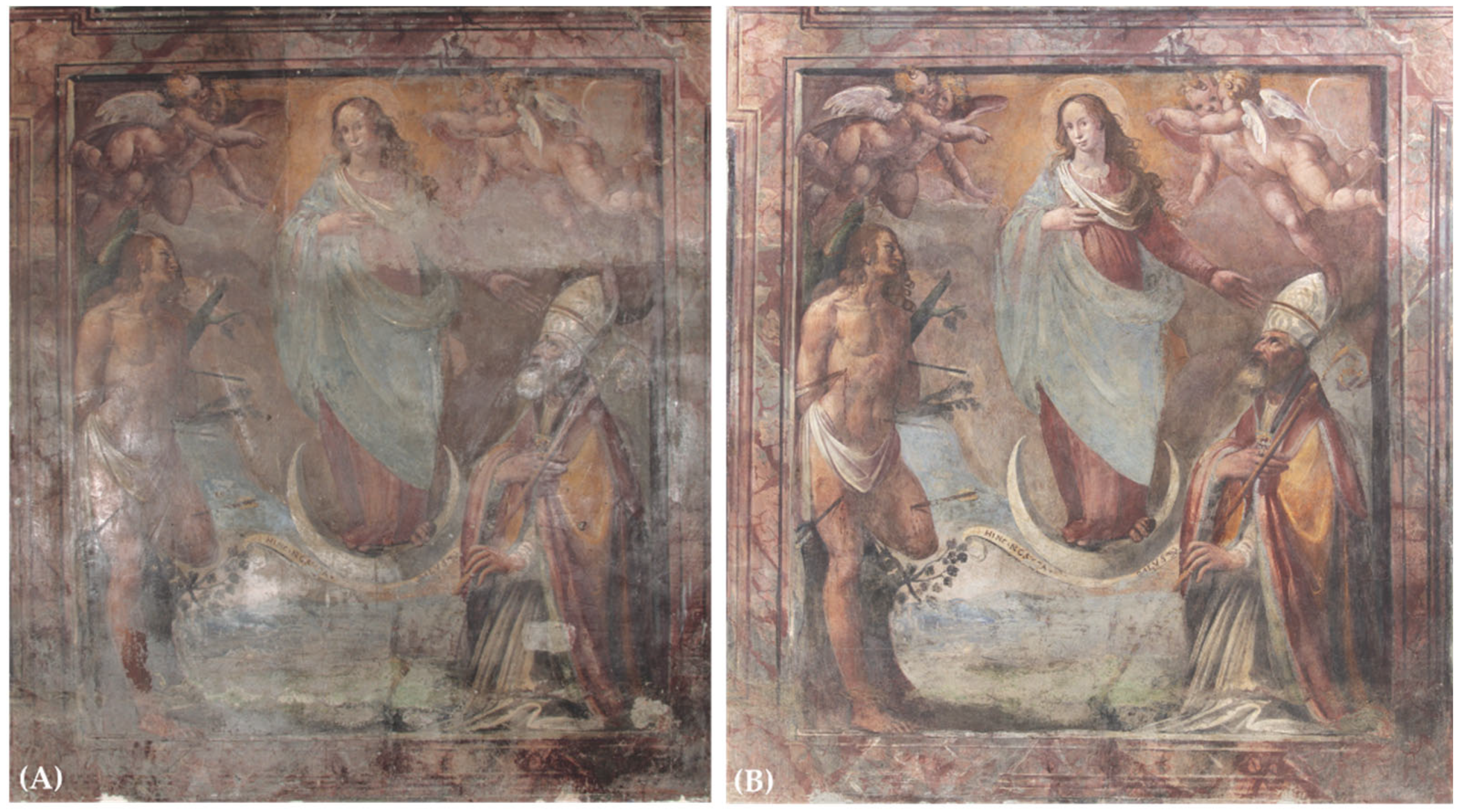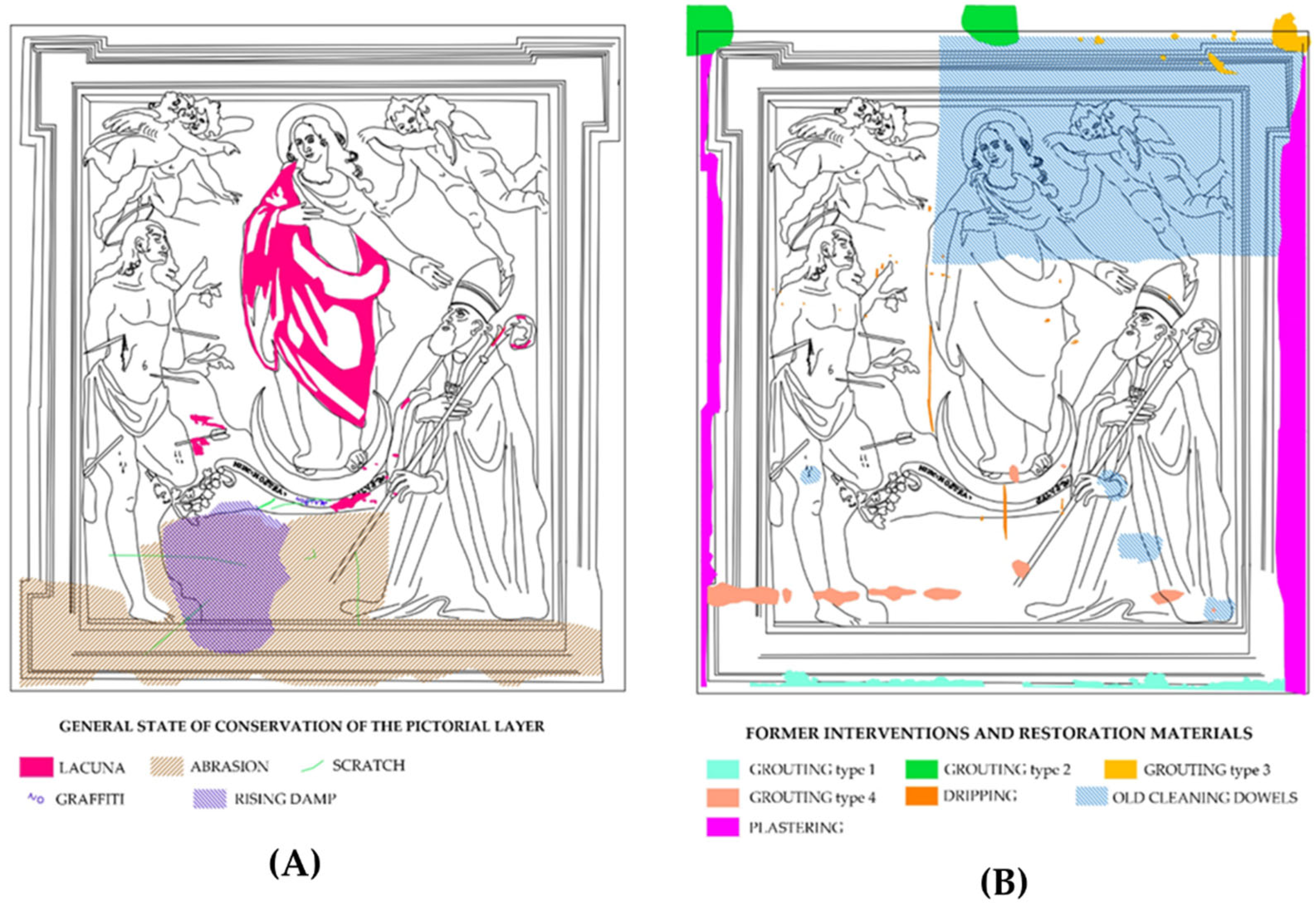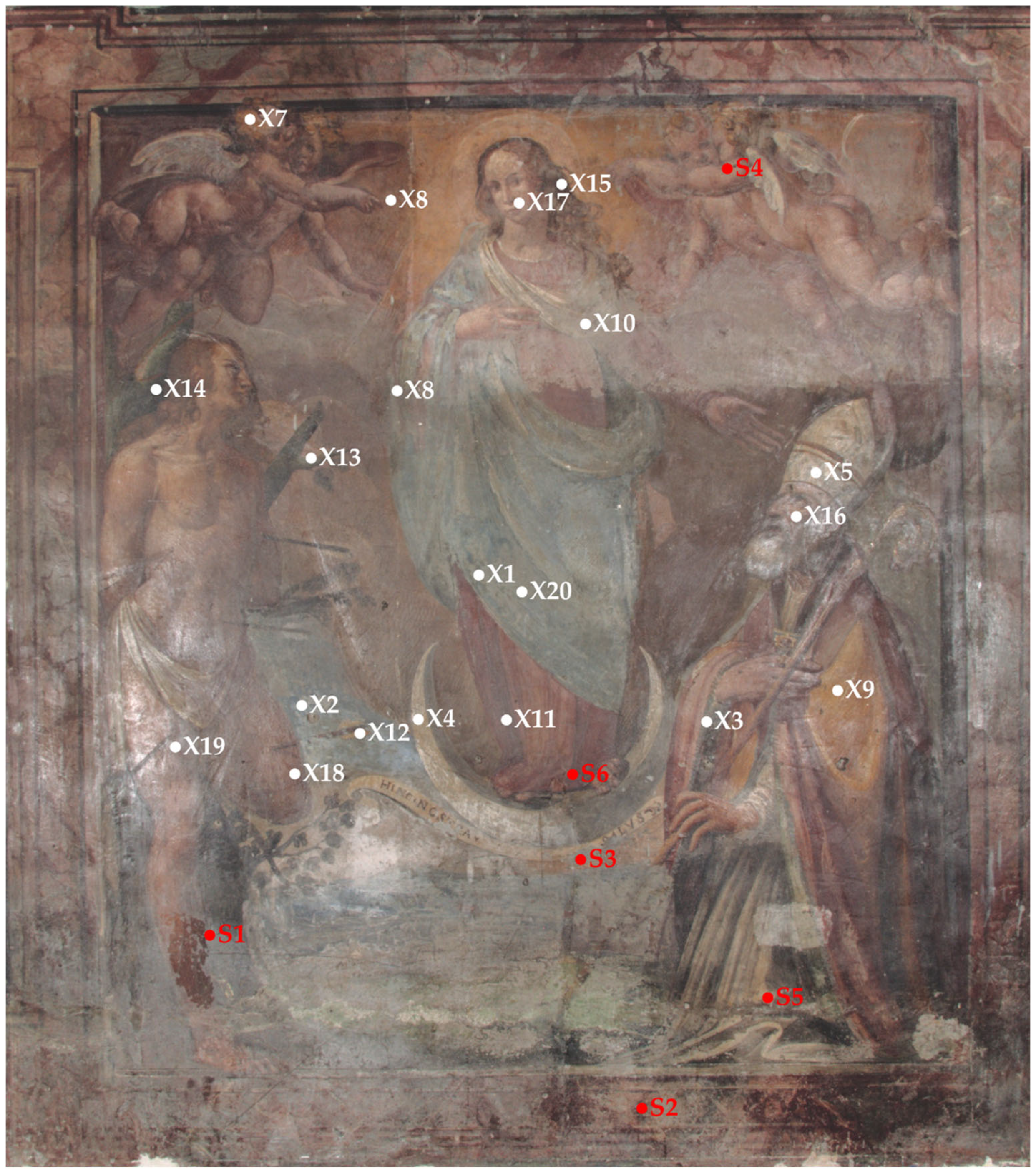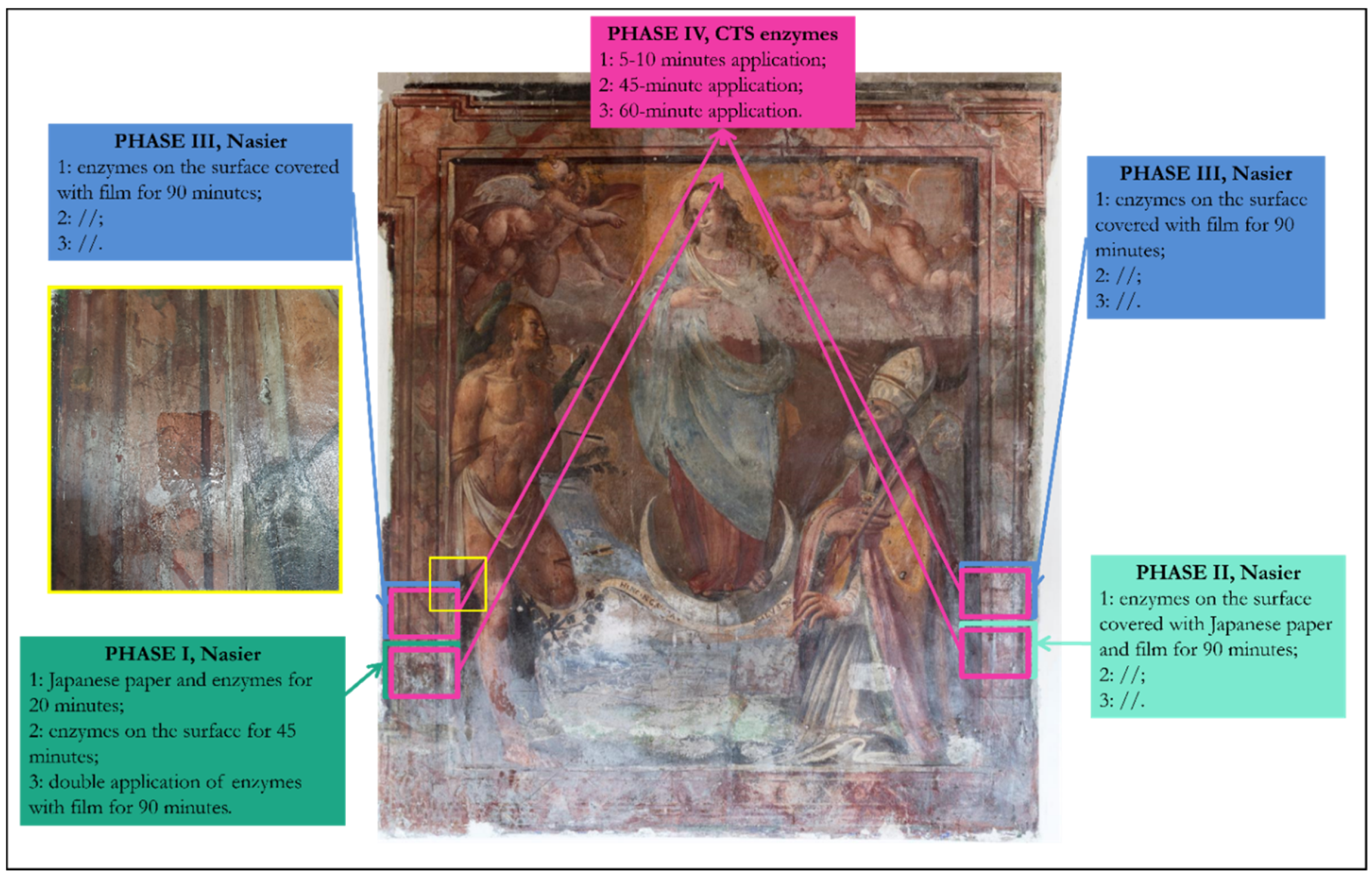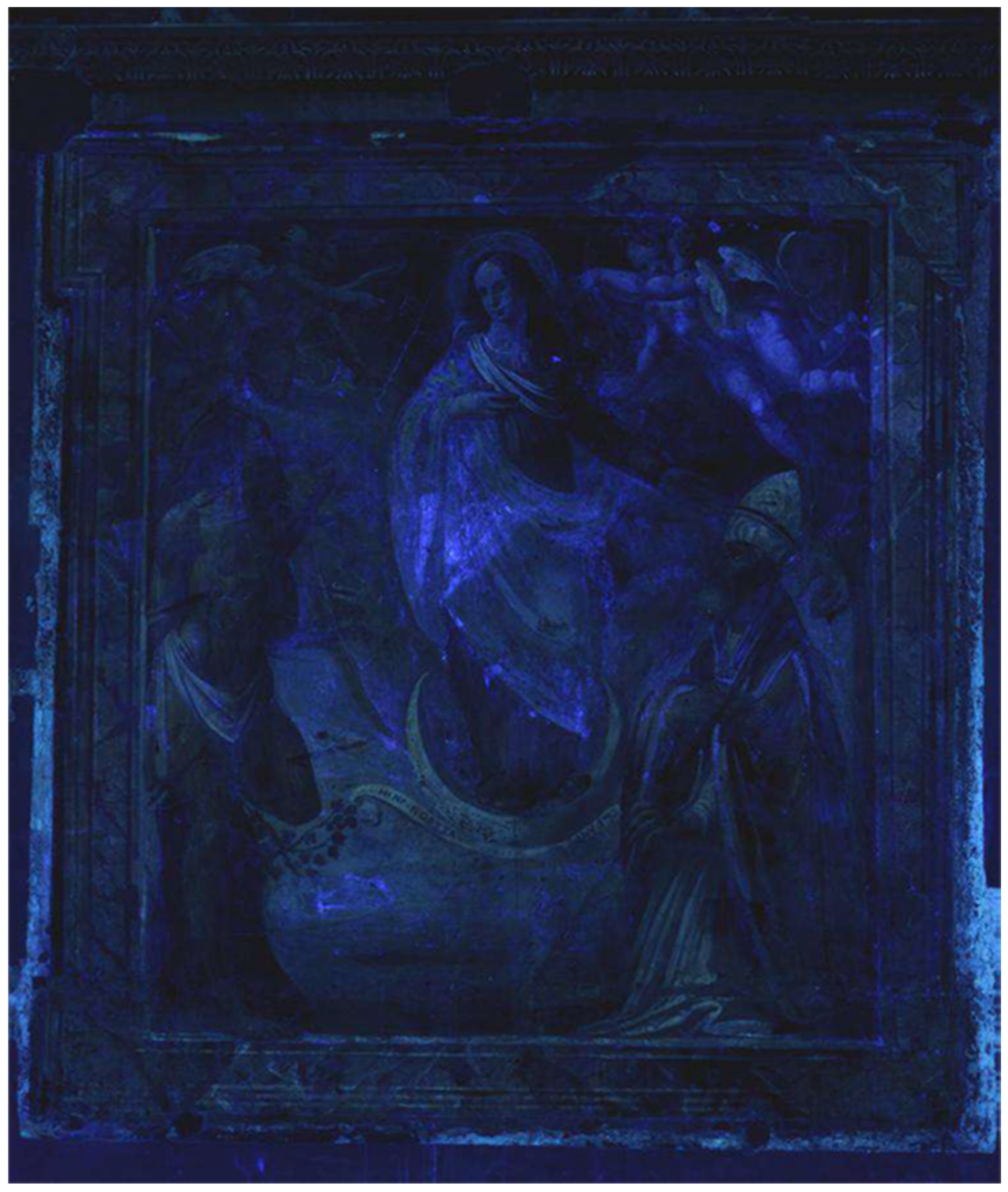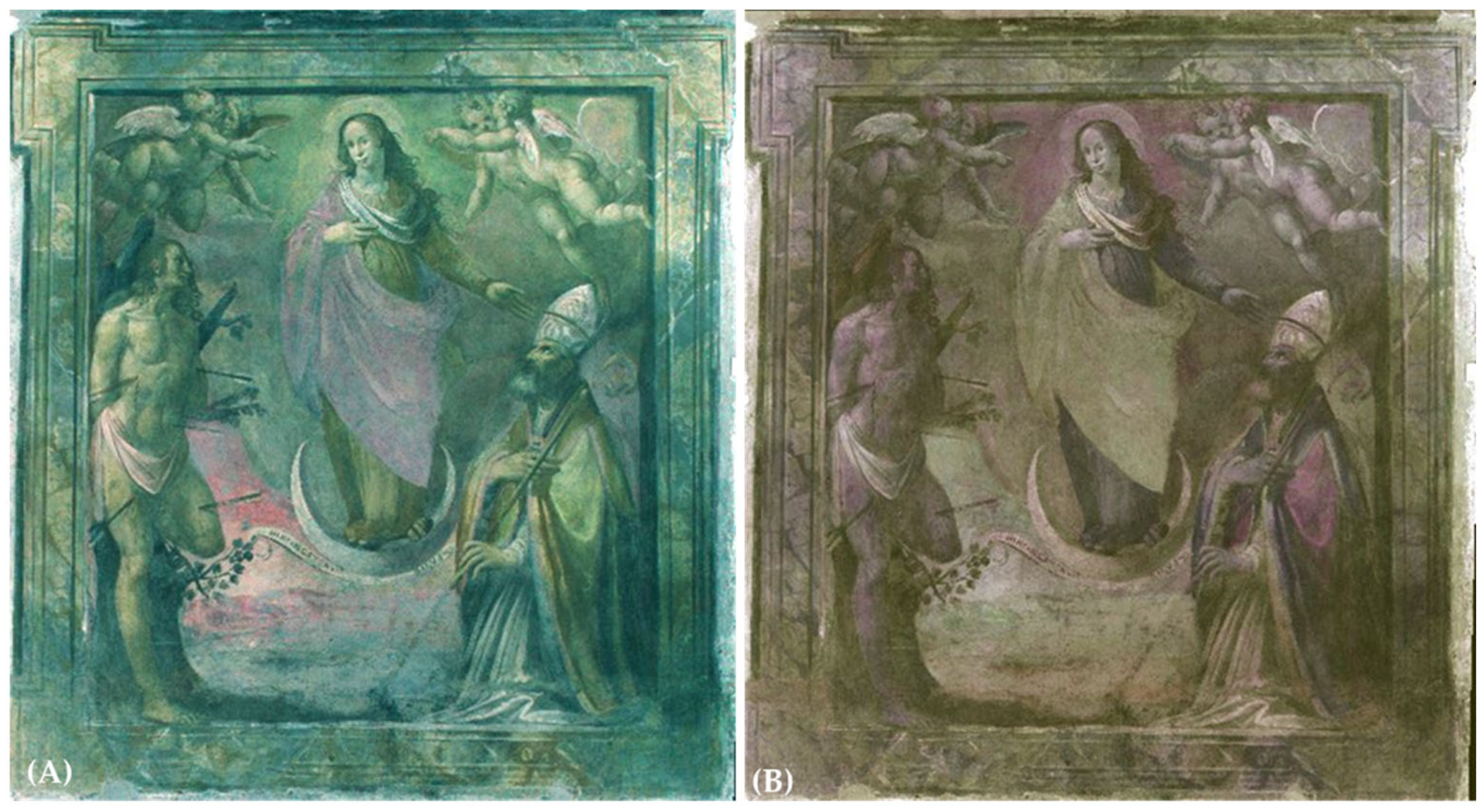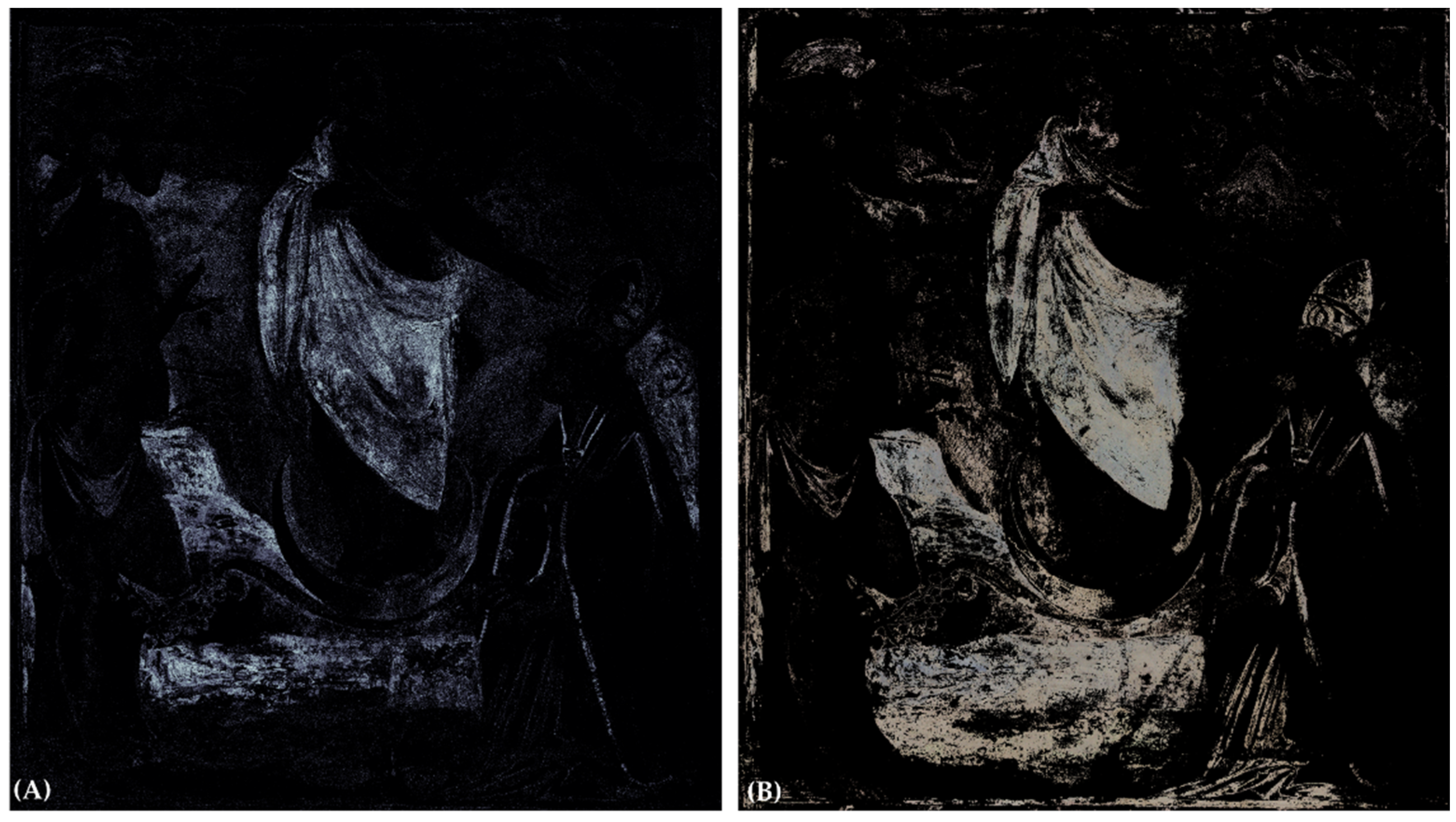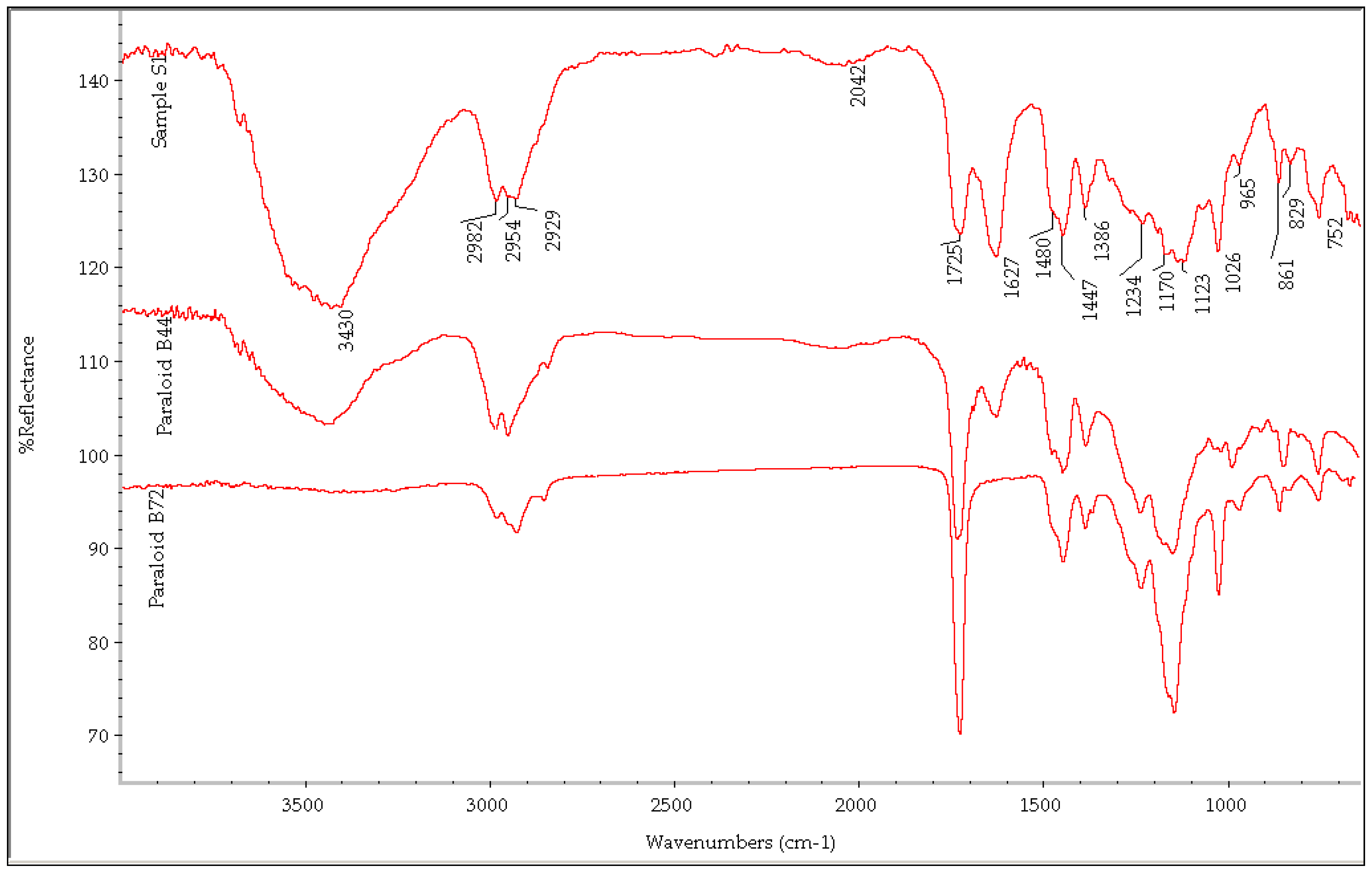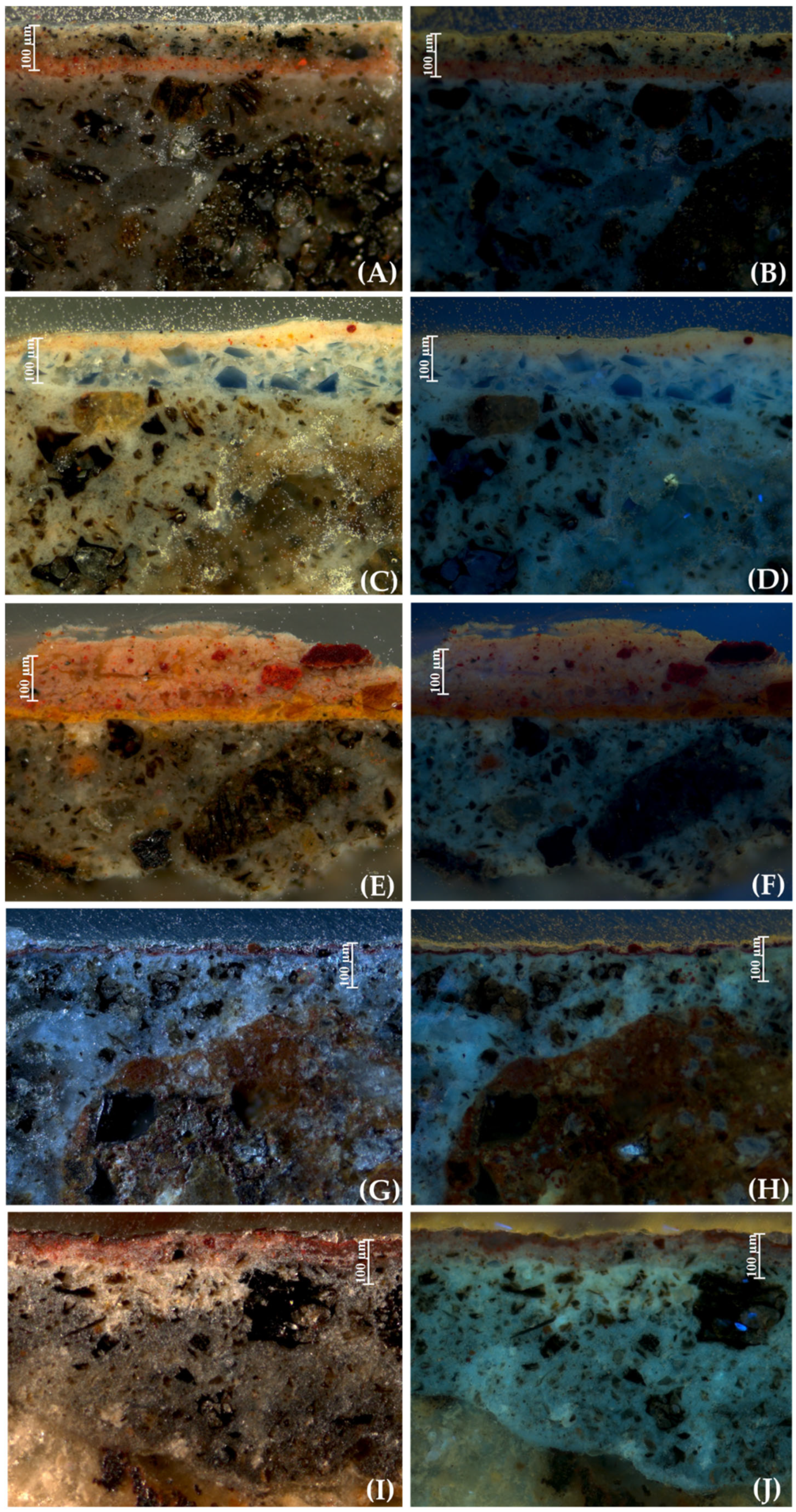1. Introduction
The rich, widespread and complex Renaissance’s artistic heritage of central Italy represent an honorable charge and a challenging task for art historians and conservators, often overshadowed by the renowned opulence of the city of Rome. But the 16th-17th century Rome of Popes delivered to history many splendid surroundings as the villages of Tuscia region around Viterbo, seat of the first conclave in history.
One of these is surely Bagnaia, a suburb on the route of the Via Francigena which host Palazzo Gallo, built between 1505 and 1521 by the will of the cardinal Raffaele Sansoni Riario [
1,
2,
3] and later owned by Gallo noble family, richly frescoed both in its inner rooms and in the outer walls.
To the main decorative apparatus, executed in all probability at the same time of the construction of the palace itself, follows a subsequent phase of painting, dated to 17th century, which includes the wall painting of the Virgin between Saints Sebastian and Saint Millerio (1.80x2.10 m
2), object of this study (
Figure 1).
The painting is placed on the west wall of the Sala Riario and both its author and client remain to this date unknown. As the most part of the paintings without author, the dating is uncertain, but stylistic examination suggest it could be placed in the early two decades of 17
th century. A study focused on the observation of all elements depicted within the painting and the way in which these are connected to each other has led to identify the theme with that of the Immaculate Conception rather than the one of Assuntion, originally suggested by art historians [
4].
In support of this attribution, in the Bagnaia wall painting the Virgin stands barefoot on a crescent moon. Such an iconography recalls a passage from John’s apocalypse (Apocalypse 12, 1-3) referring to a “woman clothed with the sun” (
mulier amicta sole). The crescent moon is indeed a recurrent symbol in the iconography of the immaculate conception, as testified by artworks of important 17
th century painters as Guido Reni, Guercino and Federico Fiori called the Barocci [
5,
6].
The use of a comparative method was fundamental for the study of the wall painting by which compositional schemes and individual figurative details appearing in contemporary pictorial artworks were juxtaposed by analogy. Investigating the workers active in Bagnaia at that time, the greater closeness, in terms of style and technique, was found with the manner of the famous Roman painter Marzio Ganassini, who learned the Mannerist school from Cavalier d’Arpino [
7]. As evidence of his importance, in the years between 16
th and 17
th century, Ganassini takes part to the decoration of prestigious churches: a document of 1598 attests him working in the church of Santa di Farfa directed by Orazio Gentileschi; from 1591 to 1601 he works in Sipicciano (province of Viterbo) at the painting of the Baglioni Chapel in the church of Santa Maria Assunta in Cielo [
8]; between 1601 and 1607 he lends his artistic skills to the decoration of the Rome churches of Santa Cecilia in Trastevere, Santa Maria della Consolazione and in the cloister of Santa Maria sopra Minerva.
The conservative history of the Virgin wall painting in Palazzo Gallo is intertwined with the one of the paintings inside and outside the palace. Between 2003 and 2004 a restoration campaign directed by Professor Giuseppe Moro from Istituto Superiore per la Conservazione e il Restauro (ISCR) who faced the removal of a firm coating using several substances as potassium hydroxide, citric acid and acetic acid delivered to the surface in a cellulose pulp pack. Unfortunately, this approach turned to be aggressive towards the pictorial layer which lost part of its original color. Last phases of Moro’s restoration saw the application of a protective layer alternating -in different and still not identified areas- mastic, dammar and shellac, Paraloid B72, Acryl AC33 and Primal in nitro diluent (information given by Marcello Labate, restorer of Moro’s team in 2004).
The degradation of this protective layer is particularly noticeable in the lower part of the wall painting, where also efflorescence phenomena due to saline rise, extensive abrasions and
lacunae are predominant (
Figure 2). Another main conservative issue for the painting is represented by the cleaning dowels of the former restoration, the most invasive of which is in the upper right and includes the two putti and the face of the Virgin. Here the aggressive cleaning caused a thinning of the pictorial layer lightening the tones of the paint with respect to the state original.
To conclude, the poor state of conservation of the painting, the entire pictorial surface is covered by a protective layer that alters the perception of the painting giving it a translucent appearance. The complex conservative framework represented a challenging restoration project but also the chance to test innovative and sustainable green products for the removal of the glossy protective, approached in this study.
Considering the established potential toxicity of traditional solvents used in the field of restoration, as well as in other application areas, scientific research is hopefully pushing towards a progressive elimination of substances which are potentially toxic for restorers and environment, choosing where possible the so-called "green" approach. Among cutting edge green technologies and products for the cleaning of painting surfaces, enzyme-based solutions arouse a considerable interest since the 1970s [
9]. Enzymes are proteins, catalysts of biochemical reactions, which have found successful application in heritage conservation due to their high selectivity towards the substrate; in the restoration field, this characteristic means the selective removal of film-forming materials such as animal and fish glues and jellies, albumin and casein, starch, vegetable glues, drying oils, fats, some waxes and some synthetic resins [
10,
11,
12,
13,
14,
15,
16,
17,
18,
19]. However, their high selectivity is also responsible for their limited operating range of effectiveness and a significant sensitivity to temperature and pH conditions. So, before applying this kind of cleaning system it is necessary to know the substrate composition and to establish the correct operative conditions.
For this reason, before starting the restoration activities, a diagnostics campaign was performed in order to deepen the knowledge of the conservative status and the materials of the artwork, both original and superimposed, as usual in the field of cultural heritage objects [
20,
21].
Imaging techniques were firstly applied to study the overall surface of the paintings, specifically ultraviolet fluorescence photography (UVF) and hypercolorimetric multispectral imaging (HMI) were used at the beginning and at the end of the intervention to check the result of the restoration [
22,
23].
The initial use of these imaging techniques helped in choosing the points for spectroscopic analysis performed by portable and laboratory methods. The on-site analysis was carried out by X-ray fluorescence spectroscopy (XRF) that allowed for detecting the main chemical elements of the paintings from which the pigment palette can be derived. Lastly, the non-invasive initial approach guided in the choice of the points of sampling to perform Fourier transform infrared spectroscopic (FTIR) analysis and micro-stratigraphic investigation on cross-section.
2. Materials and Methods
2.1. Hypercolorimetric Multispectral Imaging (HMI) and ultraviolet fluorescence photography (UVF)
Multispectral images and UVF photographs were acquired through Hypercolorimetric Multispectral Imaging (HMI), a portable system developed by Italian company Profilocolore© (Rome, Italy), consisting in a Nikon (Nital SpA, Moncalieri Torino, Italy) D800 36 Mpx camera, modified to obtain full-range (300 to 1000 nm), 3 filters named A (UV-Vis acquisition), B (Vis-NIR acquisition) and UV-IR cut (sandwiched with filter A for UVF acquisition), standard white patches and a color-checker positioned in the scene [
24,
25,
26]. The illuminating system for multispectral imaging is based on modified flashes. The UVF image was acquired using two CR230B-HP 10W UV LED projectors, peak emission at 365 nm, mounted at 45° in respect to the camera [
27].
The two acquired images, one with filter A and the other with filter B, are then calibrated through SpectraPick® (Version 1.2, created by Profilocolore, Rome, Italy) software that produces seven high resolution spectral images in .tiff format from UV to NIR at 350, 450, 550, 650, 750, 850 and 950 nm and the RGB image. The calibration procedure allows for achieving a precision higher than 95% on the spectral reflectance images and color error CIE ΔE2000 less than 2. After the calibration step, the images are uploaded in the processing software, named PickViewer® (Version 1.0, created by Profilocolore, Rome, Italy), that provides several diagnostic imaging and statistical tools to produce false color images, apply principal component analysis (PCA) to different spectral bands to enhance hidden information and mapping of materials based on their spectral reflectance or colorimetric values.
2.2. X-ray fluorescence spectroscopy (XRF)
XRF spectra were acquired by Dr. Claudio Falcucci (MIDA company, Rome, Italy) with a portable in-house built XRF spectrometer operating with the following settings: Au tube at 40 kV, current 0.04 mA, acquisition time equal to 50 s. The instrument was equipped with an Si-PIN detector (resolution 155 eV at 5.9 keV). XRF analyses were done on 20 points of the painted surface in order to characterize pigments of the original painting palette and eventual restoration and/or degradation products. The points of XRF analysis are shown in the
Figure 3.
2.3. Laboratory Analysis on Micro-Samples
2.3.1. Fourier Transform Infrared Spectroscopy (FTIR)
Infrared spectroscopic analysis was done to characterize the glossy restoration coating covering a large extent of the wall painting’s surface. FTIR spectrum of sample S1 was acquired using a Nicolet Avatar 360 spectrometer with DTGS detector (deuterated tri-glycine sulfate), interferometer of Michelson and accessory for diffuse reflectance analysis (DRIFT). About 5 mg of sample was used, mixed and ground with potassium bromide (KBr) of spectrophotometric grade that was used also as a background. A number of 128 spectra were acquired in the mid-infrared region (400-4000 cm
-1) with a resolution of 4 cm
-1. Spectra processing was performed in Thermo’s OMNIC version 8.0 software of Fisher Scientific Inc. The reading and interpretation of the spectra was based on management tools available in above mentioned software, scientific literature [
28,
29,
30,
31], on-line databases [
32,
33] and in-house libraries created by the Laboratory of Diagnostics and Materials Science of the University of Tuscia.
2.3.2. Microstratigraphic analysis on cross-sections
Five micro-samples (S2-S6) were selected and taken from the wall painting to prepare cross—sections for microscope examination, choosing marginal portion of the artwork or in correspondence with pre-existing lacunae. Sample cross-sections were prepared by LabSTONE snc (Palermo, Italy) after having embedded the micro-samples in a resin, suitably cut and polished. The prepared cross-section was observed with a polarized light microscope Zeiss Axioskop; equipped with reflected, transmitted and UV lighting. The images were acquired through Zeiss AxioCam NRc (Zeiss, Oberkochen, Germany) camera and processed using AxioVision software to trace the sequence of stratigraphic layers and to recognize possible traces of organic material or characteristic fluorescence of materials by means of observation with ultraviolet radiation.
2.4. Testing of enzyme-based cleaning products
In this work, enzyme-based gels produced by two Italian companies, Brenta (Milan, Italy) and CTS© (Altavilla Vicentina, Vicenza, Italy), were tested on the Virgin’s wall painting to approach a sustainable restoration of the artwork using innovative and environmentally friendly cleaning products.
The enzyme-based system by Brenta and named Nasier Lapideo L02 is an aqueous gel, ready to use, that was applied by brush in two different test area of the painting.
The CTS product must be prepared immediately before use. The CTS kit is composed of the solid enzyme mixture (containing lipase and esterase), a supporting agent named Klugel G (hydroxy-propyl-cellulose) and a washing solution to remove the residues from the surfaces at the end of the treatment.
The application times may be different depending on the conservation state of the surface and on the temperature of the environment.
Brenta suggests the times as indicated in the
Table 1. CTS technical data sheet suggests much lower times, from 1 to 10 minutes without dependence from the temperature: the right time should be selected after preliminary tests of the surfaces to be treated.
The products were applied by brush in two selected test areas, as synthetically reported in the
Figure 4. The areas were chosen in marginal part of the painting in order to preserve the integrity of the main parts of the scene, such as the figures and the angels. The application times are generally higher than those proposed by Brenta and CTS. This was due to the poor results obtained with the times indicated in the technical data sheets, so, in accordance with the companies, higher treatment times were tested.
Various phases were necessary due to practical adjustments requested for selecting the most suitable times and conditions. In fact, one important aspect of the work, concerned the need to adapt the commercial products to a real case because the indications supplied in the technical data sheets were not appliable to the wall painting object of the present study. To make an example, Nasier Lapideo L02 gel had a low viscosity and dripped onto the wall, so it was necessary to contact the Brenta company which was available to design a new gel with higher viscosity.
3. Results
3.1. HMI and UVF output
Before restoration, multispectral images investigations were performed through HMI technique and UVF photography to analyze the general state of conservation of the pictorial layer and identify original painting materials. Imaging data were processed in HMI software PickViewer® allowing to fully detect bruising, lacunae, grouting and plastering of former restorations, as well as to characterize original painting materials through calibrated false color imaging analysis and to map pigments’ distribution through digital image processing algorithms.
UVF image (
Figure 5) was acquired before restoration to appreciate the general state of conservation of the wall painting and to highlight the presence of the residual restoration coating whose fluorescence is clearly visible along the cracks of the pictorial layer and it is more concentrated in some areas as the body of the top right cherub, the left part of the Virgin’s mantle and a small portion of the sky under St. Sebastian bent knee.
False color images (
Figure 6) allow to hypothesize the presence of smalt blue pigment for the Virgin’s mantle and for the sky painted in the lower part of the scene, as it typically becomes wine-red in IRFC and light green in UVFC [
23,
34,
35]. Another pigment that could be supposed on the base of its response in false color images is vermilion/cinnabar which appear bright yellow in IRFC and dark violet in UVFC (
Figure 6B) and it can be observed in the edges of the mantle of Saint Millerio.
To map the distribution of probable smalt blue and to further explore the potentiality of HMI processing software, the multispectral similarity tool and the cluster analysis (applied on the three IR bands) of PickViewer® were applied to the calibrated images by selecting a 3x3 pixels area in a blue zone of the Virgin dress. The results are shown in the
Figure 7. The white pixels highlight the points where a pigment with similar spectral characteristics of that in the Virgin garment is present. The blue pigment appears more concentrated in the Virgin garment and in the background, but it is present also in other zones of the painting, such as in the mantle of St. Millerio and in the wings of the angel in the upper left side, as better highlighted by the cluster analysis whose result is shown in the
Figure 7B.
3.2. XRF data
The results of XRF analysis are summarized in
Table 1 where the detected elements are listed in order of decreasing abundance. The data revealed the joint presence of calcium (Ca), iron (Fe), rubidium (Rb), strontium (Sr) and zirconium (Zr), attributable to the constituent materials of the mortar, based on lime (to which calcium and strontium can be referred) and of a material of volcanic origin similar to pozzolana (characterized by the presence of iron, rubidium and zirconium). The analysis is not able to identify the possible presence of an additional silicate filler (due to the impossibility to detect silicon) or a carbonate one (the calcium of the charge would not be distinguishable from that of the binder). The ubiquitous presence of lead (Pb) could suggest the presence of this element -in trace amounts in the mortar filler. Alternatively, the same element could be related to the use of modest quantities of lead white (or another lead-based pigment, for example minium/red lead) by the painter. In the blue points, a constant presence of arsenic (As), cobalt (Co), nickel (Ni) and bismuth (Bi) was detected, which allow to identify the use of smalt. Residues of this pigment are also present in correspondence with the lacunae of the pictorial layer in the Virgin’s mantle.
In the red-colored areas, as well as for the red component of the skin-tone of St. Millerio, the XRF analysis indicates the presence of mercury and iron that indicates the use of vermilion/cinnabar (HgS) and earth pigments. On the other hand, vermilion/cinnabar seems absent from the red brushstrokes of the blood that gushes from the wounds on St. Sebastian’s legs, painted with red earths. In the tracts of blood with a more orange and brilliant color, the increase in intensity of the lead fluorescence line and the simultaneous decrease of that of iron might suggest that minium was also employed. However, it is necessary to consider that XRF analysis cannot reveal the presence of organic dye pigments, which could have been used for the making of blood. In some points XRF detected traces of arsenic, as in correspondence of the white in the crescent moon on which the Virgin stands, in the brightest yellow light of the mantle of San Millerio (whose color is attributable to yellow ocher) and in the dark part of the red robe of the Virgin. Here the presence of arsenic could be due to the use of very small quantity of smalt blue (in which cobalt, nickel and bismuth would be in quantities less than detection limits of the instrument in the adopted configuration), or to impurities of this element in some earth pigments, or to the use of orpiment (As2S3) and/or realgar (As4S4). The latter hypothesis seems however rather unlikely, considering the low photon counting rate related to arsenic, not sufficient to provide a chromatic perception in the painting. Lastly, an arsenic contamination could also be traced back to residues of sanitizing treatments of wooden elements, such as the extensive ones of the ceiling of the room hosting the wall painting.
Table 2.
Chemical elements detected through XRF, reported in descending order of X-ray counts.
Table 2.
Chemical elements detected through XRF, reported in descending order of X-ray counts.
| Point |
Color |
Detected elements |
Hypothesized pigments |
| X1 |
Blue (clear) |
As, Sr, Fe, Ca, Rb, Co, Bi, Zr, Pb |
Smalt blue + lead white |
| X2 |
Blue (clear) |
As, Fe, Sr, Co, Ca, Bi, Zr, Ni, Rb, Pb |
Smalt blue + lead white |
| X3 |
Blue (clear) |
Fe, As, Sr, Ca, Co, Rb, Bi, Ni, Pb, Zr |
Smalt blue + earth pigments + lead white |
| X4 |
White |
Ca, Sr, Fe, As, Rb, Zr, Pb |
Calcium carbonate + lead white |
| X5 |
White |
Ca, Sr, Rb, Zr, Fe, Pb |
Calcium carbonate + lead white |
| X6 |
Yellow |
Fe, Ca, Sr, Rb, Zr, Pb |
Calcium carbonate + yellow ochre |
| X7 |
Yellow |
Fe, Ca, Sr, Rb, Zr, Pb |
Calcium carbonate + yellow ochre |
| X8 |
Yellow |
Fe, Ca, Sr, Rb, Pb |
Calcium carbonate + yellow ochre |
| X9 |
Yellow |
Fe, Sr, Ca, Rb, Pb, As |
Yellow ochre |
| X10 |
Red |
Fe, Ca, Sr, Hg, Rb, Pb |
Red earth + cinnabar |
| X11 |
Red |
Fe, Hg, Ca, Sr, Rb, As, Pb |
Red earth + cinnabar |
| X12 |
White |
Ca, As, Sr, Pb, Bi, Fe, Zr, Co, Rb, Ni |
Smalt blue + lead white + earth pigments |
| X13 |
Green |
Fe, Sr, Ca, As, Pb, Rb, Zr, Co, Bi, Ni |
Earth pigment + lead white + smalt blue |
| X14 |
Green |
Fe, Sr, Ca, Rb, Zr, Pb |
Earth pigment + lead white |
| X15 |
Pink (clear) |
Ca, Fe, Sr, Rb, Pb |
Calcium carbonare + earth pigments + lead white |
| X16 |
Pink |
Ca, Fe, Sr, Hg, Rb, Pb |
Earth pigments + cinnabar + lead white |
| X17 |
Brown |
Fe, Ca, Sr, Rb, Hg, Mn, Pb |
Red earth + cinnabar + umber |
X18
X19
X20 |
Red
Red
Blue (clear) |
Ca, Sr, Fe, Rb, Zr, Pb, Mn
Fe, Sr, Ca, Zr, Rb, Pb
Sr, Fe, Ca, Zr, Rb, As, Co, Pb, Ni, Bi |
Red earth + cinnabar + umber
Red earth + lead white or minimum
Smalt blue + lead white |
3.3. Results of the analysis on micro-samples
3.3.1. FTIR data
FTIR analysis was carried out on a sample (S1, localized in the
Figure 3) of the translucent finishing of the painting with the aim at characterizing the main constituents and choosing the most effective cleaning strategy.
The spectrum obtained is shown in the
Figure 8 together with the reference spectra of Paraloid B44 and Paraloid B72.
In fact, the research in the databases and in the texts reported in paragraph 2.3.1 gave a match with acrylic resins, specifically Paraloid B72 and Paraloid B44. The main signatures of such polymers are: 1725 cm-1 (C=O stretching); 2982, 2954 and 2929 cm-1 (stretching of C-H bonds), 140-1300 cm-1 region (bending of the C-H bonds), and 1300-900 cm-1 region (stretching of the C-O bonds). The presence of a synthetic resin of acrylic typology is so confirmed as mentioned by the restorer Marcello Labate who worked on the painting during the restoration campaign directed by prof. Moro in 2004.
3.3.2. Result of microstratigraphic analysis
The cross-sections, under visible reflected lighting and ultraviolet fluorescence, are shown in the
Figure 9. They were used mainly to investigate the painting technique in different portion of the wall decoration. In all cases the painting layer s well-adhered to the mortar suggesting the use of a fresco technique. This assessment may be further confirmed by the absence of fluorescence in the painting layer, apart from the pale blue one that could be associated to calcium carbonate, the main constituent of the mortar and binder of the pigments. The painting layers have different thickness, sometimes, as in sample S5 (
Figure 9G,H) only few microns that, in fact, represents the preparatory drawing generally made of the so-called sinopia, a red earth based of iron oxides. In the cross-section of sample S5 the protective applied in the past restoration is visible on the surface and exhibits an orange fluorescence. This same response is partially visible also in the samples S1 and S6 cross-sections.
Sample S3, from the blue background in the lower part of the painting, clearly shows the smalt glassy particles applied by fresco technique with a superimposed yellow layer that could be associated to the decorative element under the Virgin’s foot. This result suggests that the blue background was painted on the entire surface, at least in this portion of the wall painting, and the yellow decoration was applied after directly on the blue smalt. A layers’ superimposition is visible in the sample S2 cross-section where the thin red layer, used to create the false marble decoration of the frame, is covered by a discontinuous black layer that could be due to sooty material fixed by the protective of the 2003-2004 restoration.
Sample S4 cross-section shows and orange think layer adhering to the mortar and two pinky and thick layers used to make the flesh tone.
The surface of sample S4 cross-section is partially detached and appears discontinuous. This appearance can be explained by the hard cleaning treatment performed on the occasion of the 2003-2004 restoration, clearly visible in the painting photo before our work (see
Figure 1A, upper right side of the painting).
3.3. Results of cleaning tests
After confirming the presence of Paraloid through FT-IR analysis, it was decided to test the green products from Nasier-Brenta for the cleaning of the painted surface. The company’s enzymes Nasier Lapideo L02, as specified in the technical data sheet, is a ready-to-use product for stone surfaces which is specific for the removal of organic patinas such as waxes, drying oils, oleo-resinous paints, repaintings and synthetic compounds as acrylic and vinyl esters and Paraloid B72.
In the first applications, the aqueous gel based on stabilized enzymes (lipases) had problems with the adhesion to the substrate due to its excessive fluidity, causing the solution to drip as soon as it was applied on the painting, thus preventing the correct functioning of the enzymes (
Table 3). It was then decided to contact the company, which provided a new sample specifically designed to overcome this problem (PHASE III in the
Table 3, Naser L02 modified).
This second formulation had clearly a greater density than the first solution, but still not enough to stably cling to the surface. Following a further consultation with the company, it was decided to cover the gel with a layer of transparent film to hold the gel on the surface and avoid its possible evaporation. Unfortunately, even with these adjustments, the tests did not achieve the desired results as no consistent improvement was registered.
It was therefore decided to test the enzymatic cleaning provided by CTS company. As reported in the technical data sheet, the product is a mixture of purified lipase/esterase enzymes in dehydrated form with a supporting solution containing Klucel G; it is specific for the removal of natural waxes, synthetic resins such as esters, acrylics and vinyl and drying oils. The CTS product consists of one dose of enzyme in powder form, a thickening dose for the supporting solution and a washing solution which is an operating procedure very different from that developed by the Nasier company which did not require any preparation. Nonetheless, also CTS green product did not meet the expectations for a proper cleaning of the painting.
The results of the cleaning tests performed on selcted areas of the wall panting are summarized in the
Table 3.
4. Discussion
Art restoration is a complex process where different issues should equally converge: a proper recovery of the aesthetics and mechanical/physical conditions of the artwork; healthy working conditions for the restorers; limited chemical products and residual waste materials to dispose at the end of the restoration; sustainable costs to afford for a complete diagnostic study and restoration of the artwork and, last but not least, timing compatible with the clients and the renewed fruition of the artwork. This ideal management of the restoration procedure often clashes with the fact that many conservation methodologies lack durability, sustainability, and cost-effectiveness and are typically based on energy-consuming processes or non-environmentally friendly materials. At the current state of the art, there are still numerous conservation-restoration practices which are hardly challenging for environment protection; cleaning is by far the crucial passage in art restoration and a critical operation for ecological issues considering that it implies the use of solvents and other toxic chemicals. Nonetheless, a growing awareness is registered in restoration field where environmental impact is earning more space in the scientific discussion of effective cleaning protocols available. Indeed, sustainable research and alternative materials are being developed and the sharing of good practices is spreading together with a more solid acceptance of climate change and environmental emergency due to plastics and pollutants which require long-term strategies.
Unfortunately, sometimes green protocols successfully applied for a category of artworks are not effective for a specific case study, or not compatible with the needs of the restoration campaign. It is the case of the Palazzo Gallo’s wall-painting presented in this study, where enzymatic products for stone cleaning by Nasier-Brenta© and by CTS could not provide appreciable results in acceptable timing, leading restorers to choose a traditional chemical product as Dowanol for the cleaning of the altered varnish.
A disappointing result does not compromise the path of an increasing awareness in waste management in restoration campaigns, reducing the usage of chemicals and non-recyclable supporters, but should remind that this path is still complex, and more efforts need to be done to find solutions that can customize to real cases. New green protocols need to be tested focusing on their monitoring and possible interface changes for life cycle assessment of sustainable products to propose effective, affordable, safe, and user-friendly solutions for restorers and conservators.
Author Contributions
Conceptualization, V.V., C.P. and L.L.; methodology, C.P. and V.V.; software, L.L., C.C. and R.B.; validation, C.P., L.L., R.B. and V.V.; formal analysis, L.L., C.C and C.P.; investigation, C.P., L.L. and C.C.; resources, C.P. and V.V.; data curation, R.B., C.C. and L.L.; writing—original draft preparation, C.C. and C.P.; writing—review and editing, all authors; visualization, C.P., C.C. and L.L.; supervision, C.P. and V.V.; project administration, C.P. and V.V.; funding acquisition, C.P. and V.V.
Funding
This research received no external funding.
Institutional Review Board Statement
Not applicable.
Informed Consent Statement
Not appliable.
Data Availability Statement
No data available.
Acknowledgments
The authors would like to thank Brenta and CTS companies for their support and help during the tests with their commercial products; Dr. Clauda Falcucci of MIDA society for the XRF analysis. A special thank goes to “Amici di Bagnaia” Association that gave a great contribution concerning the historical documentation about the painting and a support in the logistics.
Conflicts of Interest
The authors declare no conflict of interest.
References
- Serone, G. Le mura medievali di Bagnaia. Analisi diacronica di un manufatto architettonico. In Il Tesoro delle città. Strenna dell’Associazione Storia delle Città; Edizioni Kappa: Roma, Italy, 2007; pp. 473–491. [Google Scholar]
- Pezzuto, L., ed. La Roma di Raffaele Riario tra XV e XVI secolo. Cultura antiquaria e quartieri decorativi. Horti Hesperidum 2017, Fascicolo 1.
- Vettraino, R.; Valentini, V.; Pogliani, P.; Ricci, M.; Laureti, S.; Calvelli, S.; Zito, R.; Lanteri, L.; Pelosi, C. Multi-Technique Approach by Traditional and Innovative Methodologies to Support the Restoration of a Wall Painting from the 16th Century at Palazzo Gallo in Bagnaia, Viterbo, Central Italy. Buildings 2023, 13, 783. [Google Scholar] [CrossRef]
- Ricci, S. Bagnaia e Villa Lante. La fortuna riflessa di un centro minore del Lazio; Edizioni Saverio Ricci: San Gemini (TR), Italy, 2017. [Google Scholar]
- Hibbard, H. Guido Reni’s Painting of the Immaculate Conception. The Metropolitan Museum of Art Bulletin 1969, 28, 19–32. [Google Scholar] [CrossRef]
- Morello, G.; Francia, V.; Fusco, R. (Eds.) Una donna vestita di sole. L’Immacolata Concezione nelle opere dei grandi Maestri, 1st ed.; Motta: Milano, Italy, 2005; p. 238. [Google Scholar]
- Röttgen, H. (Ed.) Il Cavalier d’Arpino; De Luca: Roma, Italy, 1973; pp. 39, 78-79, 110-111, 163. [Google Scholar]
- Mancini, C.; Profili, S. Il giovane Marzio Ganassini firma gli affreschi della Cappella Baglioni di Sipicciano. Biblioteca e Società 2019, 72, 42–51. [Google Scholar]
- Wendelbo, O.; Fosse, B. Protein “Surgey” A Restoring Procedure Applied on Paper. Restaurator 1970, 1, 245–248. [Google Scholar]
- Segal, J.; Cooper, D. The use of enzymes to release adhesives. Pap. Conserv. 1977, 2, 47–50. [Google Scholar] [CrossRef]
- Cooper, D.; Segal, J. The use of enzyme in partially non aqueous media. In Conservation of Library and Archive Materials and the Graphic Arts, 1st ed.; Butterworth: London, UK, 1980; pp. 25–30. [Google Scholar]
- Bellucci, R.; Cremonesi, P.; Pignagnoli, G. A note on the use of enzymes in conservation. A preliminary report on the removal of aged acrylic resin coatings with Lipase. Stud. Conserv. 1999, 44, 278–281. [Google Scholar] [CrossRef]
- Beutel, S.; Klein, K.; Knobbe, G.; Königfeld, P.; Petersen, K.; Ulber, R.; Scheper, T. Controlled enzymatic removal of damaging casein layers on medieval wall paintings. Biotechnol. Bioeng. 2002, 80, 13–21. [Google Scholar] [CrossRef]
- Ranalli, G.; Alfano, G.; Belli, C.; Lustrato, G.; Colombini, M.P.; Bonaduce, I.; Zanardini, E.; Abbruscato, P.; Cappitelli, F.; Sorlini, C. Biotechnology applied to cultural heritage: biorestoration of frescoes using viable bacterial cells and enzymes. J. Appl. Microbiol. 2005, 98, 73–83. [Google Scholar] [CrossRef] [PubMed]
- Ahmed, H.E.; Kolisis, F.N. An investigation into the removal of starch paste adhesives from historical textiles by using the enzyme α-amylase. J. Cult. Herit. 2011, 12, 169–179. [Google Scholar] [CrossRef]
- Pereira, C.; Busani, T.; Branco, L.C.; Joosten, I.; Anca Sandu, I.C. Nondestructive characterization and enzyme cleaning of painted surfaces: assessment from the macro to nano level. Microsc. Microanal. 2013, 19, 1632–1644. [Google Scholar] [CrossRef]
- Palla, F. Blue-biotechnology and Biocleaning of historic-artistic artifacts. Conserv. Sci. Cult. Herit. 2016, 16, 185–196. [Google Scholar]
- Jeszeová, L.; Bauerová-Hlinková, V.; Baráth, P.; Puškárová, A.; Bučková, M.; Kraková, L.; Pangallo, D. Biochemical and proteomic characterization of the extracellular enzymatic preparate of Exiguobacterium undae, suitable for efficient animal glue removal. Appl. Microbiol. Biotechnol. 2018, 102, 6525–6536. [Google Scholar] [CrossRef] [PubMed]
- Cremonesi, P.; Casoli, A. Enzymes as tools for conservation of works of art. J. Cult. Herit. 2021, 50, 73–87. [Google Scholar] [CrossRef]
- Ricci, M.; Laureti, S.; Malekmohammadi, H.; Sfarra, S.; Lanteri, L.; Colantonio, C.; Calabrò, G.; Pelosi, C. Surface and Interface Investigation of a 15th Century Wall Painting Using Multispectral Imaging and Pulse-Compression Infrared Thermography. Coatings 2021, 11, 1–23. [Google Scholar] [CrossRef]
- Groppi, F.; Vigliotti, D.; Lanteri, L.; Agresti, G.; Casoli, A.; Laureti, S.; Ricci, M.; Pelosi, C. Advanced documentation methodologies combined with multi-analytical approach for the preservation and restoration of 18th century architectural decorative elements at Palazzo Nuzzi in Orte (Central Italy). International Journal of Conservation Science 2021, 12, 921–934. [Google Scholar]
- Bonizzoni, L.; Caglio, S.; Galli, A.; Lanteri, L.; Pelosi, C. Materials and Technique: The First Look at Saturnino Gatti. Appl. Sci. 2023, 13, 6842. [Google Scholar] [CrossRef]
- Annarilli, S.; Casoli, A.; Colantonio, C.; Lanteri, L.; Marseglia, A.; Pelosi, C.; Sottile, S. A Multi-Instrument Analysis of the Late 16th Canvas Painting, “Coronation of the Virgin with the Saints Ambrose and Jerome”, Attributed to the Tuscany-Umbria Area to Support the Possibility of Bio-Cleaning Using a Bacteria-Based System. Heritage 2022, 5, 2904–2921. [Google Scholar] [CrossRef]
- Laureti, S.; Colantonio, C.; Burrascano, P.; Melis, M.; Calabrò, G.; Malekmohammadi, H.; Sfarra, S.; Ricci, M.; Pelosi, C. Development of integrated innovative techniques for the examination of paintings: the case studies of The Resurrection of Christ attributed to Andrea Mantegna and the Crucifixion of Viterbo attributed to Michelangelo’s workshop. J. Cult. Herit. 2019, 40, 1–16. [Google Scholar] [CrossRef]
- Colantonio, C.; Clivet, L.; Laval, E.; Coquinot, Y.; Maury, C.; Melis, M.; Boust, C. Integration of multispectral imaging, XRF mapping and Raman analysis for noninvasive study of illustrated manuscripts: the case study of fifteenth century Humay meets the Princess Humayun Persian masterpiece from Louvre Museum. Eur. Phys. J. Plus 2021, 136. [Google Scholar] [CrossRef]
- Colantonio, C.; Lanteri, L.; Ciccola, A.; Serafini, I.; Postorino, P.; Censorii, E.; Rotari, D.; Pelosi, C. Imaging Diagnostics Coupled with Non-Invasive and Micro-Invasive Analyses for the Restoration of Ethnographic Artifacts from French Polynesia. Heritage 2022, 5, 215–232. [Google Scholar] [CrossRef]
- Lanteri, L.; Pelosi, C. 2D and 3D ultraviolet fluorescence applications on cultural heritage paintings and objects through a low-cost approach for diagnostics and documentation. In Proceedings of the SPIE 11784, Optics for Arts, Architecture, and Archaeology VIII, Munich, Germany, 8 July 2021; pp. 1–10. [Google Scholar]
- Derrick, M.R.; Stulik, D.C.; Landry, J.M. Infrared Spectroscopy in Conservation Science, 1st ed.; Getty Conservation Institute: Los Angeles, USA, 1999. [Google Scholar]
- Miliani, C.; Rosi, F.; Daveri, A.; Brunetti, B.G. Reflection infrared spectroscopy for the non-invasive in situ study of artists’ pigments. Appl. Phys. A 2012, 106, 295–307. [Google Scholar] [CrossRef]
- Walker, J.; Hodgkins, R.; Berrie, B. On the Surface: Reflectance FTIR Spectroscopy in Cultural Heritage Research. Microscopy and Microanalysis 2021, 27 (Suppl. S1), 2800–2804. [Google Scholar] [CrossRef]
- Vahur, S.; Teearu, A.; Peets, P.; Joosu, L.; Leito, I. ATR-FT-IR spectral collection of conservation materials in the extended region of 4000-80 cm-1. Anal. Bioanal. Chem. 2016, 408, 3373–3379. [Google Scholar] [CrossRef]
- IRUG. Infrared and Raman User Group. Available online: http://www.irug.org/search-spectral-database (accessed on 18 September 2023).
- Database of ATR-FT-IR spectra of various materials. Available online: https://spectra.chem.ut.ee/ (accessed on 18 September 2023).
- Moon, T.; Schilling, M.R.; Thirkettle, S. A Note on the Use of False-Color Infrared Photography in Conservation. Stud. Conserv. 1992, 37, 42–52. [Google Scholar] [CrossRef]
- Cosentino, A. Identification of pigments by multispectral imaging a flow chart method. Herit. Sci. 2014, 2, 1–12. [Google Scholar] [CrossRef]
|
Disclaimer/Publisher’s Note: The statements, opinions and data contained in all publications are solely those of the individual author(s) and contributor(s) and not of MDPI and/or the editor(s). MDPI and/or the editor(s) disclaim responsibility for any injury to people or property resulting from any ideas, methods, instructions or products referred to in the content. |
© 2023 by the authors. Licensee MDPI, Basel, Switzerland. This article is an open access article distributed under the terms and conditions of the Creative Commons Attribution (CC BY) license (https://creativecommons.org/licenses/by/4.0/).
